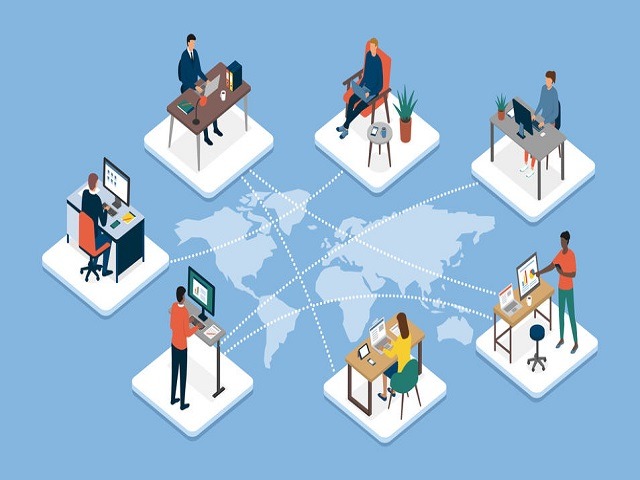Making Telework Work: The upsides, downsides and the way forward (Part 2)

In the previous blog (Part 1) we identified and discussed the upsides and downsides of telework: Positive aspects, such as such as easing societal problems related to densely populated areas, increasing feelings of autonomy and enhanced performance; But also negative aspects, such as vanishing boundaries of life domains, extended working hours, professional isolation and leadership challenges.
In this blog we focus on: what companies can and should do when organizing their workplace in the future.
Several Dutch companies have already announced that they will not return to their usual way of working once people could return to their offices. Instead, they want to continue teleworking, although to a smaller degree. How should the post-pandemic workplace look like? As many workers enjoy working from home, it may be tempting for organizations to stick to (part-time) teleworking practices to reduce office space permanently, cut company costs and at the same time be an attractive employer. But there are several important challenges ahead. These points have to be taken into account to make telework work in the long term.
1. Securing autonomy
Telework should always happen on a voluntary basis. It is very important to take into account worker´s individual needs. Some people may not want or are not able to work from home. They may prefer clear physical boundaries between life domains or personal circumstances prevent them from working at home comfortably. They need and should have an office on-site permanently.
2. Limiting telework to less than 50% of weekly working time
Beneficial effects of telework fail to unfold or even turn negative when people work a large share of their total work time at home. Alternating on-site work and with telework seems to be most beneficial. Part-time telework provides individual autonomy but also helps to establish a sense of community.
3. Redesigning workspaces
Regarding office design, refrain from open offices. Many companies have tried it and it did not work well (for a start, see for instance [1]). More promising approaches to office design are smaller and potentially fewer cellular or shared offices with own desks. So called territorial workspaces which can be personalized to a certain degree - for instance in terms of personal decorations and preferred ergonomic tools - help employees to feel comfortable and safe at work. Employees who feel that their office reflects their identity, experience more place-ownership, which results in higher psychological commitment to their organization [2].
4. Creating an inclusive telework culture
A workforce with a significant share of teleworkers on each day of the week poses coordination challenges. If organizations reduce workspaces, employees cannot be on-site all at the same time. This means that some meetings should remain online. Similar to a language etiquette, any meeting with at least one participant based at home, should be held online. This is crucial to ensure fair and inclusive workplaces for all and prevent teleworking employees to be “out of sight, out of mind”.
5. Addressing legal and occupational safety challenges
Working outside the company´s premises poses a number of legal and occupational safety challenges which will need to be resolved (e.g., data security, work accidents, poor ergonomics). Collective labor agreements and trade union involvement are essential in this process, too.
6. Training supervisors
Supervisors are in need for training to support employees partly based at home and on-site. For instance, detecting when employees struggle is more difficult to recognize from a distance and once issues surface, it may already be too late (for an evidence-based training, see [3]). Management of teleworkers also requires precise arrangements on the desired level of production per unit of time and trust.
7. Supporting employees: practically and financially
For employees who do make use of telework opportunities, financial and practical support for creating sound workspaces at home needs to be provided. For instance, ergonomics advice and financial compensation for desks, additional screens and office chairs.
Employees may also benefit from support in creating boundaries between life domains and managing their time so that they have enough leisure throughout the day and between days to recover from their work. Self-monitoring tools for keeping track of work hours may be helpful in this regard. Finally, with a partly teleworking workforce, there is a greater risk that some co-workers will never meet each other at the office. Departmental social activities or activities for specific target groups within an organization, as well as mentoring programs for junior workers and/or new workers entering the organization can foster support networks, and establish cohesive and safe workplaces.
To conclude, telework offers tremendous opportunities and many of us have gotten a taste of this within the last years. However, telework signifies a major cultural change within organizations. Most importantly, it entails a change from a face-to-face culture to a culture focusing on objectives and output. The role of work hours, which has been used as a proxy for effort invested, may become meaningless in evaluating people´s work. Having time and creating time for oneself becomes both ever more precious and challenging when work and private life merge within one´s own home.
Authors:
Further reading/listening
- Telework in the European Union: https://www.eurofound.europa.eu/sites/default/files/ef_files/docs/eiro/tn0910050s/tn0910050s.pdf
- Telework in the EU before and after the COVID-19: where we were, where we head to: https://ec.europa.eu/jrc/sites/jrcsh/files/jrc120945_policy_brief_-_covid_and_telework_final.pdf
- Eurofund on telework in the Netherlands (prevalence, regulatory framework, positions of social partners): https://www.eurofound.europa.eu/fr/publications/article/2008/telework-in-the-netherlands
- European framework agreement on telework (2002): https://www.etuc.org/en/framework-agreement-telework
- Report on telework experiences at the University of Groningen: https://myuniversity.rug.nl/infonet/medewerkers/actueel/news/2021/0408-eng-rapportage-thuiswerken-in-coronatijd-deel-2.pdf
- Tips and thoughts on telework: Pyörä, P. (2011). Managing telework: risks, fears and rules. Management Research Review: https://tinyurl.com/2pkepume
- Podcast about working life after the pandemic (in Dutch): https://www.bnr.nl/podcast/werkverkenners/10432453/werken-na-corona


